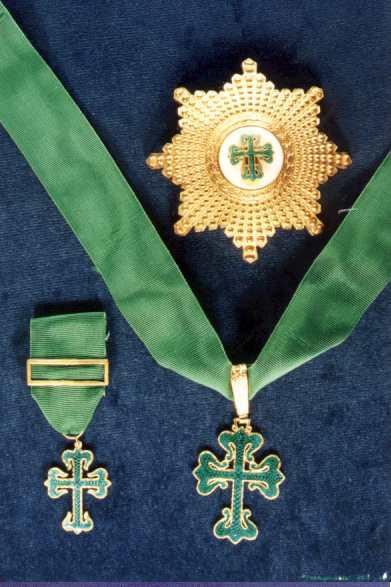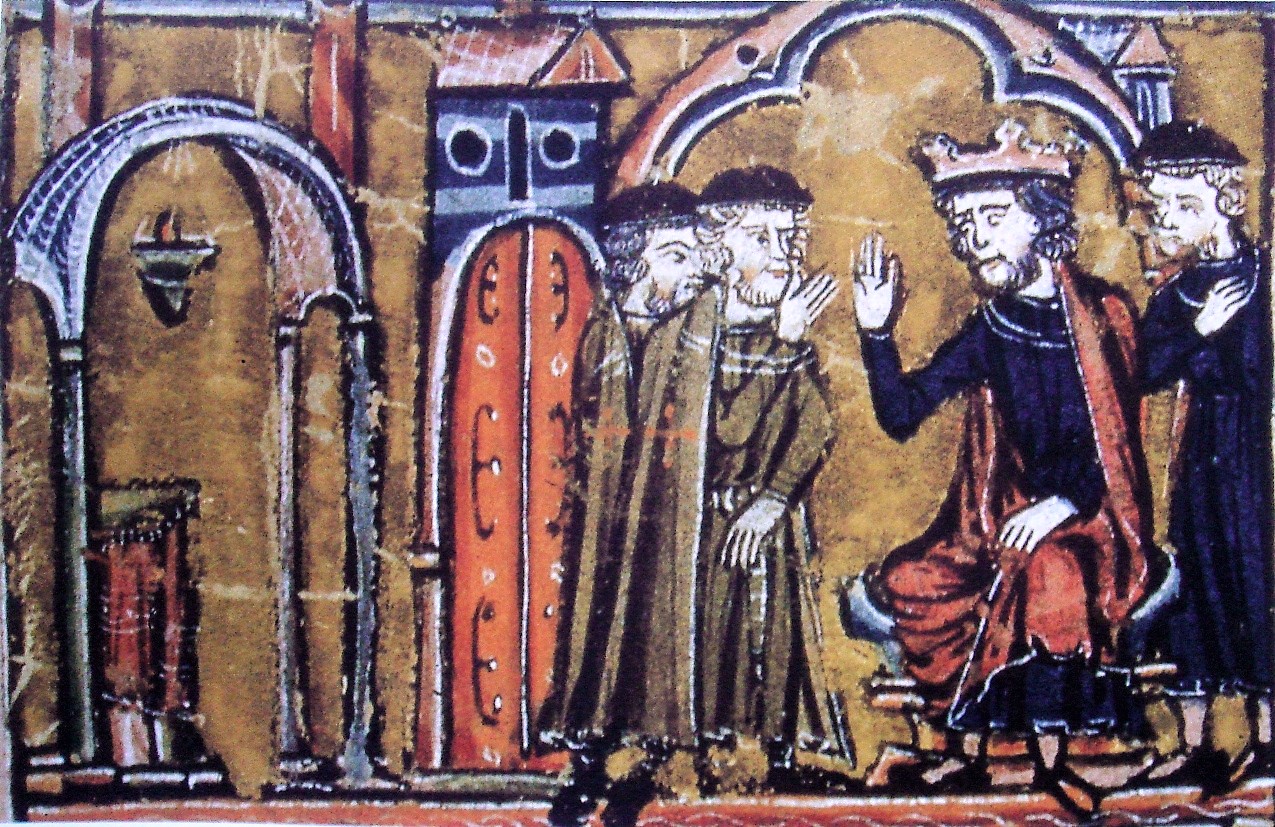|
Order Of Aviz
The Military Order of Saint Benedict of Aviz ( pt, Ordem Militar de São Bento de Avis, ), previously to 1910 ''Royal Military Order of Saint Benedict of Aviz'' ( pt, Real Ordem Militar de São Bento de Avis), previously to 1789 ''Knights'' (of the ''Order) of Saint Benedict of Aviz'' ( pt, Ordem de São Bento de Aviz) or ''Friars of Santa Maria of Évora'', is a Portuguese order of chivalry, founded in Portugal in 1146. It gave its name and coat of arms to the Aviz Dynasty that ruled Portugal between 1385 and 1580. Early history The order, as a monastic military order, was founded in emulation of such military orders as the Knights Templar, which existed in Portugal as early as 1128, and received a grant from Theresa, Countess of Portugal in the year of the Council of Troyes, which confirmed their early statutes. A native order of this kind sprang up in Portugal about 1146. Afonso, the first king, gave to it the town of Évora, captured from the Moors in 1166, and the Knig ... [...More Info...] [...Related Items...] OR: [Wikipedia] [Google] [Baidu] |
Council Of Troyes 1129
The Council of Troyes was convened by Bernard of Clairvaux on 13 January 1129 in the city of Troyes. The council, largely attended by French clerics, was assembled to hear a petition by Hugues de Payens, head of the Knights Templar. Pope Honorius II did not attend the council, sending the papal legate, Matthew, cardinal-bishop of Albano. The council addressed issues concerning the Templar Order and a dispute between the bishop of Paris and king of France. Background Founded by Hugues de Payens in 1119, the Knights Templar had gained the backing of King Baldwin II at the Council of Nablus in 16 January 1120. In 1126, Baldwin had commissioned two clerics to speak with Bernard of Clairvaux seeking papal recognition and a Rule for the Templar Order. Later, Baldwin sent Hugues to Europe to convince Fulk of Anjou to marry his daughter Melisende and to raise an army for a crusade against Damascus. Hugues's other objectives were to gain papal recognition, recruit members for the Order ... [...More Info...] [...Related Items...] OR: [Wikipedia] [Google] [Baidu] |
Battle Of Tangier (1437)
The Battle of Tangier, sometimes referred to as the Siege of Tangiers and, by the Portuguese, as the Disaster of Tangier ( pt, Desastre de Tânger), refers to the attempt by a Portuguese expeditionary force to seize the Moroccan citadel of Tangier and its defeat by the armies of the Marinid Sultanate, in 1437. The Portuguese expeditionary force, led by Prince Henry the Navigator, Duke of Viseu, set out from Portugal in August 1437, intending to seize a series of Moroccan coastal citadels. The Portuguese laid siege to Tangier in mid-September. After a few failed assaults on the city, the Portuguese force was attacked and defeated by a large Moroccan relief army led by vizier Abu Zakariya Yahya al-Wattasi of Fez. The Moroccans encircled the Portuguese siege camp and starved it to submission. To preserve his army from destruction, Henry negotiated a treaty promising to return the citadel of Ceuta (captured earlier in 1415) to Morocco in return for being allowed to withdraw his tr ... [...More Info...] [...Related Items...] OR: [Wikipedia] [Google] [Baidu] |
Conquest Of Ceuta
The conquest of Ceuta by the Portuguese on 21 August 1415 marks an important step in the beginning of the Portuguese Empire in Africa. History In 711, shortly after the Arab conquest of North Africa, the city of Ceuta was used as a staging ground in the Umayyad conquest of Hispania. However, the city was destroyed in 740 and only rebuilt in the 9th century, passing to the Caliphate of Córdoba in the 10th century. In the subsequent centuries it remained under the rule of the Almoravids and Almohads as well as various Andalusian Taifas. Prior to its capture by the Portuguese, Ceuta had seen a period of political instability in previous decades, under competing interests from the Marinid Empire and the Kingdom of Granada. In the early 1400s, Portugal cast an eye at gaining Ceuta. The prospect of taking of Ceuta offered the younger nobility an opportunity to win wealth and glory. The chief promoter of the Ceuta expedition was João Afonso, royal overseer of finance. Ceut ... [...More Info...] [...Related Items...] OR: [Wikipedia] [Google] [Baidu] |
Council Of Basle
The Council of Florence is the seventeenth ecumenical council recognized by the Catholic Church, held between 1431 and 1449. It was convoked as the Council of Basel by Pope Martin V shortly before his death in February 1431 and took place in the context of the Hussite Wars in Bohemia and the rise of the Ottoman Empire. At stake was the greater conflict between the conciliar movement and the principle of papal supremacy. The Council entered a second phase after Emperor Sigismund's death in 1437. Pope Eugene IV convoked a rival Council of Ferrara on 8 January 1438 and succeeded in drawing some of the Byzantine ambassadors who were in attendance at Basel to Italy. The remaining members of the Council of Basel first suspended him, declared him a heretic, and then in November 1439 elected an antipope, Felix V. After becoming the Council of Florence (having moved to avoid the plague in Ferrara), the Council concluded in 1445 after negotiating unions with the various easte ... [...More Info...] [...Related Items...] OR: [Wikipedia] [Google] [Baidu] |
John I Of Portugal
John I ( pt, João �uˈɐ̃w̃ 11 April 1357 – 14 August 1433), also called John of Aviz, was King of Portugal from 1385 until his death in 1433. He is recognized chiefly for his role in Portugal's victory in a succession war with Castile, preserving his country's independence and establishing the Aviz (or Joanine) dynasty on the Portuguese throne. His long reign of 48 years, the most extensive of all Portuguese monarchs, saw the beginning of Portugal's overseas expansion. John's well-remembered reign in his country earned him the epithet of Fond Memory (''de Boa Memória''); he was also referred to as "the Good" (''o Bom''), sometimes "the Great" (''o Grande''), and more rarely, especially in Spain, as "the Bastard" (''Bastardo''). Early life John was born in Lisbon as the natural son of King Peter I of Portugal by a woman named Teresa, who, according to the royal chronicler Fernão Lopes in the Chronicle of the King D. Pedro I, was a noble Galician. In the 18th c ... [...More Info...] [...Related Items...] OR: [Wikipedia] [Google] [Baidu] |
Crown Of Castile
The Crown of Castile was a medieval polity in the Iberian Peninsula that formed in 1230 as a result of the third and definitive union of the crowns and, some decades later, the parliaments of the kingdoms of Castile and León upon the accession of the then Castilian king, Ferdinand III, to the vacant Leonese throne. It continued to exist as a separate entity after the personal union in 1469 of the crowns of Castile and Aragon with the marriage of the Catholic Monarchs up to the promulgation of the Nueva Planta decrees by Philip V in 1715. In 1492, the voyage of Christopher Columbus and the discovery of the Americas were major events in the history of Castile. The West Indies, Islands and Mainland of the Ocean Sea were also a part of the Crown of Castile when transformed from lordships to kingdoms of the heirs of Castile in 1506, with the Treaty of Villafáfila, and upon the death of Ferdinand the Catholic. The discovery of the Pacific Ocean, the Conquest of the Aztec Empi ... [...More Info...] [...Related Items...] OR: [Wikipedia] [Google] [Baidu] |
Ferdinand I Of Portugal
Ferdinand I ( pt, Fernando; 31 October 1345 – 22 October 1383), sometimes called the Handsome () or occasionally the Inconstant (), was the King of Portugal from 1367 until his death in 1383. His death led to the 1383–85 crisis, also known as the Portuguese interregnum. Life Ferdinand was born in Coimbra, the second but eldest surviving son of Peter I and his wife, Constanza Manuel. On the death of Peter of Castile in 1369, Ferdinand, as great-grandson of Sancho IV by his grandmother Beatrice, laid claim to the vacant Castilian throne. The kings of Aragon and Navarre, and later John of Gaunt, Duke of Lancaster, who had married Peter of Castile's eldest daughter, Constance, also claimed the throne. The throne was held by his second cousin Henry of Trastámara (Henry II of Castile), Peter of Castile's illegitimate brother, who had defeated him in the Castilian Civil War in 1366 and assumed the crown. After one or two indecisive campaigns, all parties were ready t ... [...More Info...] [...Related Items...] OR: [Wikipedia] [Google] [Baidu] |
Calatravan Order
The Order of Calatrava ( es, Orden de Calatrava, pt, Ordem de Calatrava) was one of the four Spanish military orders and the first military order founded in Castile, but the second to receive papal approval. The papal bull confirming the Order of Calatrava was given by Pope Alexander III on September 26, 1164. Most of the political and military power of the order had dissipated by the end of the 15th century, but the last dissolution of the order's property did not occur until 1838. Origins and foundation It was founded at Calatrava la Vieja in Castile, in the twelfth century by St. Raymond of Fitero, as a military branch of the Cistercian family. The etymology of the name of this military order, Calatrava, conveys the meaning: "fortress of Rabah". Rodrigo of Toledo describes the origins of the order: Calatrava is the Arabic name of a castle recovered from the Muslims, in 1147, by the King of Castile, Alfonso VII, called ''el Emperador''. Located in what was then t ... [...More Info...] [...Related Items...] OR: [Wikipedia] [Google] [Baidu] |
Cistercian
The Cistercians, () officially the Order of Cistercians ( la, (Sacer) Ordo Cisterciensis, abbreviated as OCist or SOCist), are a Catholic religious order of monks and nuns that branched off from the Benedictines and follow the Rule of Saint Benedict, as well as the contributions of the highly-influential Saint Bernard of Clairvaux, known as the Latin Rule. They are also known as Bernardines, after Saint Bernard himself, or as White Monks, in reference to the colour of the "cuculla" or cowl (choir robe) worn by the Cistercians over their habits, as opposed to the black cowl worn by Benedictines. The term ''Cistercian'' derives from ''Cistercium,'' the Latin name for the locale of Cîteaux, near Dijon in eastern France. It was here that a group of Benedictine monks from the monastery of Molesme founded Cîteaux Abbey in 1098, with the goal of following more closely the Rule of Saint Benedict. The best known of them were Robert of Molesme, Alberic of Cîteaux and the English mon ... [...More Info...] [...Related Items...] OR: [Wikipedia] [Google] [Baidu] |
Benedictine
, image = Medalla San Benito.PNG , caption = Design on the obverse side of the Saint Benedict Medal , abbreviation = OSB , formation = , motto = (English: 'Pray and Work') , founder = Benedict of Nursia , founding_location = Subiaco Abbey , type = Catholic religious order , headquarters = Sant'Anselmo all'Aventino , num_members = 6,802 (3,419 priests) as of 2020 , leader_title = Abbot Primate , leader_name = Gregory Polan, OSB , main_organ = Benedictine Confederation , parent_organization = Catholic Church , website = The Benedictines, officially the Order of Saint Benedict ( la, Ordo Sancti Benedicti, abbreviated as OSB), are a monastic religious order of the Catholic Church following the Rule of Saint Benedict. They are also sometimes called the Black Monks, in reference to the colour of their religious habits. The ... [...More Info...] [...Related Items...] OR: [Wikipedia] [Google] [Baidu] |



.jpg)

